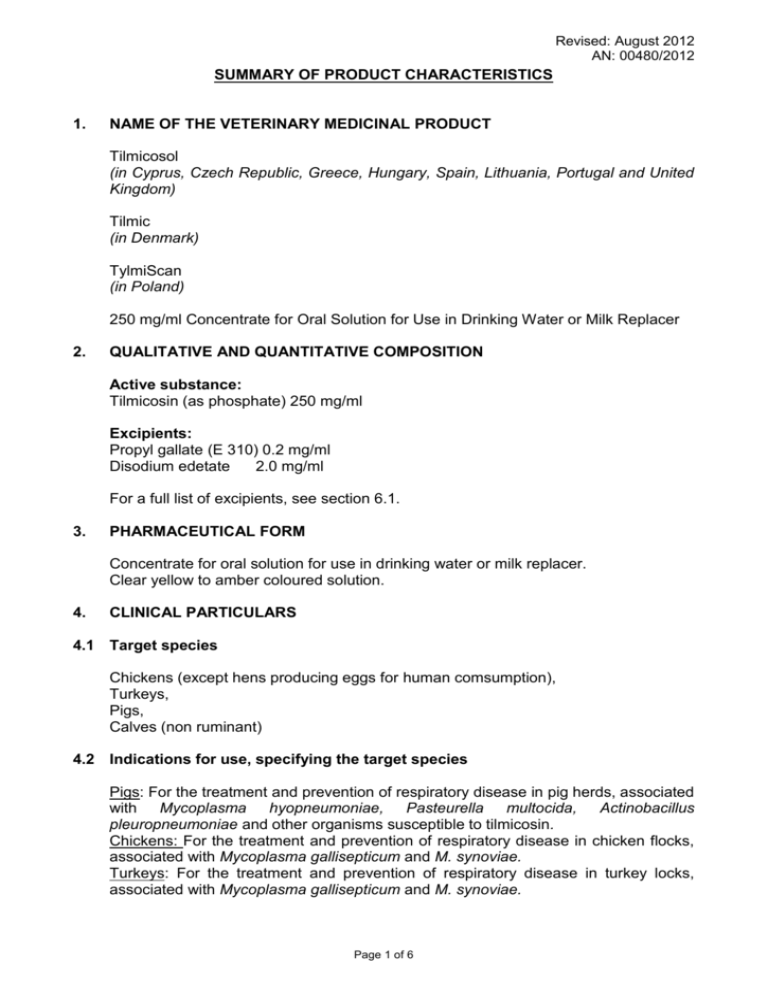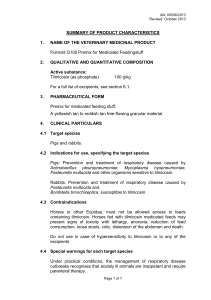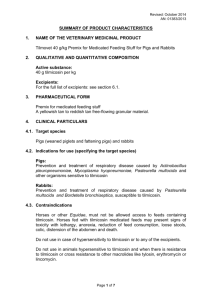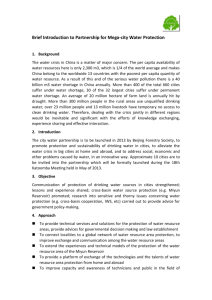Revised: August 2012 AN: 00480/2012 Summary of Product
advertisement

Revised: August 2012 AN: 00480/2012 SUMMARY OF PRODUCT CHARACTERISTICS 1. NAME OF THE VETERINARY MEDICINAL PRODUCT Tilmicosol (in Cyprus, Czech Republic, Greece, Hungary, Spain, Lithuania, Portugal and United Kingdom) Tilmic (in Denmark) TylmiScan (in Poland) 250 mg/ml Concentrate for Oral Solution for Use in Drinking Water or Milk Replacer 2. QUALITATIVE AND QUANTITATIVE COMPOSITION Active substance: Tilmicosin (as phosphate) 250 mg/ml Excipients: Propyl gallate (E 310) 0.2 mg/ml Disodium edetate 2.0 mg/ml For a full list of excipients, see section 6.1. 3. PHARMACEUTICAL FORM Concentrate for oral solution for use in drinking water or milk replacer. Clear yellow to amber coloured solution. 4. CLINICAL PARTICULARS 4.1 Target species Chickens (except hens producing eggs for human comsumption), Turkeys, Pigs, Calves (non ruminant) 4.2 Indications for use, specifying the target species Pigs: For the treatment and prevention of respiratory disease in pig herds, associated with Mycoplasma hyopneumoniae, Pasteurella multocida, Actinobacillus pleuropneumoniae and other organisms susceptible to tilmicosin. Chickens: For the treatment and prevention of respiratory disease in chicken flocks, associated with Mycoplasma gallisepticum and M. synoviae. Turkeys: For the treatment and prevention of respiratory disease in turkey locks, associated with Mycoplasma gallisepticum and M. synoviae. Page 1 of 6 Revised: August 2012 AN: 00480/2012 Calves: For the treatment and prevention of bovine respiratory disease, associated with Mannheimia haemolytica, Pasteurella multocida, Mycoplasma bovis, M. dispar and other organisms susceptible to tilmicosin. 4.3 Contraindications Do not allow horses and other equines access to drinking water containing tilmicosin. Do not use in case of hypersensitivity to tilmicosin or to any of the excipients. Do not administer to ruminating animals with active rumen function. 4.4 Special warnings for each target species Important: Must be diluted before administration to animals Pigs, chickens and turkeys: Water consumption should be monitored in order to guarantee adequate dosing. In case water consumption does not match quantities for which recommended concentrations were calculated, the concentration of Tilmicosol has to be adapted in a way that the recommend dosage will be taken up by the animals or different medication should be considered. 4.5 Special precautions for use i. Special precautions for use in animals For oral use only. Contains disodium edetate; do not inject Severely ill individuals tend to drink less and may need simultaneous treatment, preferably by parenteral medication. Inappropriate use of the product may increase the prevalence of bacteria resistant to tilmicosin and may decrease the effectiveness of treatment with tilmicosin-related substances. The use of the product should be based on susceptibility tests. Medicated drinking water or milk replacer should be prepared fresh every 24 hours. Official, national and regional antimicrobial policies should be taken into account when the product is used. ii. Special precautions to be taken by the person administering the veterinary medicinal product to animals Tilmicosin may induce irritation. Macrolides, such as tilmicosin, may also cause hypersensitivity (allergy) following injection, inhalation, ingestion or contact with skin or eye. Hypersensitivity to tilmicosin may lead to cross reactions to other macrolides and vice versa. Allergic reactions to these substances may occasionally be serious and therefore direct contact should be avoided. To avoid exposure during preparation of the medicated drinking water, wear overalls, safety glasses, and impervious gloves. Do not eat, drink or smoke when handling this product. Wash hands after use. In the case of accidental ingestion, wash out mouth immediately with water and seek medical advice. In the event of accidental skin contact, wash thoroughly with soap and water. In case of accidental eye contact, flush the eyes with plenty of clean, running water. Do not handle the product if you are allergic to ingredients in the product. Page 2 of 6 Revised: August 2012 AN: 00480/2012 If you develop symptoms following exposure, such as skin rash, you should seek medical advice and show the physician this warning. Swelling of the face, lips and eyes or difficulty in breathing are more serious symptoms and require urgent medical attention. iii. Special precautions for the environment Manure from treated animals should not be deposited on the same field in successive years. 4.6 Adverse reactions (frequency and seriousness) In very rare cases, a decrease in water intake has been observed. 4.7 Use during pregnancy, lactation or lay The safety of tilmicosin has not been established in animals used for breeding purposes. 4.8 Interaction with other medicinal products and other forms of interaction None known. 4.9 Amounts to be administered and administration route Pigs: To be included in the drinking water to provide a daily dose of 15-20 mg tilmicosin per kg bodyweight for 5 days, which may be achieved by the inclusion of 200 mg tilmicosin per litre (80 ml Tilmicosol per 100 litres). Chickens and turkeys (except hens producing eggs for human consumption): To be included in the drinking water at a daily dose of 15-20 mg/kg bodyweight in chickens and 10-27 mg/kg bodyweight in turkeys for 3 days, which may achieved by the inclusion of 75 mg tilmicosin per litre (30 ml Tilmicosol per 100 litres). Calves: To be included in milk replacer only, at a dose of 12.5 mg/kg bodyweight and given twice daily for 3-5 consecutive days, which may be achieved by the inclusion of 1 ml of product every 20 kg bodyweight The uptake of medicated water/milk replacer depends on the clinical condition of the animals. In order to obtain the correct dosage, the concentration of Tilmicosol should be adjusted accordingly. 4.10 Overdose (symptoms, emergency procedures, antidotes), if necessary When pigs are offered drinking water containing 300 or 400 mg tilmicosin/litre (equivalent to 22.5-40 mg/kg bodyweight or 1.5-2 times the recommended concentration) commonly animals exhibit a reduced water intake. Although this has a self-limiting effect on tilmicosin intake, it could, in extreme circumstances, result in dehydration. This can be corrected by the removal of the medicated drinking water and replacement with fresh unmedicated water. No symptoms of overdose have been seen in chickens given drinking water containing levels of tilmicosin up to 375 mg/litre (equivalent to 75-100 mg/kg bodyweight or 5 times the recommended dose) for 5 days, daily treatment with 75 mg/litre (equivalent to the maximum recommended dose) for 10 days resulted in a decrease in faecal consistency. Page 3 of 6 Revised: August 2012 AN: 00480/2012 No symptoms of overdose have been seen in turkeys given drinking water containing levels of tilmicosin up to 375 mg/litre (equivalent to 50-135 mg/kg bodyweight or 5 times the recommended dose) for 3 days, daily treatment with 75 mg/litre (equivalent to the maximum recommended dose) for 6 days also produced no symptoms of overdose. No symptoms of overdose, with exception of a slight decrease in the milk consumption, have been seen in calves given twice daily doses 5 times the maximum recommended dose or for twice the maximum recommended duration of treatment. 4.11 Withdrawal period(s) Meat and offal of: Pigs - 14 days Chickens - 12 days Turkeys - 19 days Calves - 42 days Not authorised for use in laying birds producing eggs for human consumption. Do not use within 14 days of onset of the laying. Not authorised for use in lactating animals producing milk for human consumption. 5. PHARMACOLOGICAL PROPERTIES Pharmacotherapeutic Group: Antibacterials for systemic use, macrolides ATCVet code: QJ01FA91 5.1 Pharmacodynamic properties Tilmicosin is a semi-synthetic antibiotic of the macrolide group, and is believed to affect protein synthesis. It has bacteriostatic action but at high concentrations it may be bactericidal. This antibacterial activity is predominantly against Gram-positive microorganism with activity against certain gram-negative ones and Mycoplasma of a bovine, porcine, ovine and avian origin. In particular, its activity has been demonstrated against the following microorganism: Pigs: Mycoplasma hyopneumoniae, Pasteurella multocida and Actinobacillus pleuropneumoniae Chickens and turkeys: Mycoplasma gallisepticum and Mycoplasma synoviae Calves: Mannheimia haemolytica, Pasteurella multocida, Mycoplasma bovis, M. dispar Scientific evidence suggests that macrolides act synergistically with the host immune system. Macrolides appear to enhance phagocyte killing of bacteria. Tilmicosin has been shown to inhibit in vitro the replication of the Porcine Reproductive and Respiratory Syndrome virus in alveolar macrophages in a dose dependent fashion. Cross-resistance between tilmicosin and other macrolides and lincomycin has been observed. Page 4 of 6 Revised: August 2012 AN: 00480/2012 5.2 Pharmacokinetic particulars Whilst blood concentrations of tilmicosin are low, there is pH-dependent macrophage accumulation of tilmicosin in inflamed tissue. Pigs: After oral administration of 200 mg tilmicosin/litre drinking water, the average active substance concentrations detected in lung tissue, alveolar macrophages and bronchial epithelium 5 days after the start of treatment were reported 1.44 μg/ml, 3.8 μg/ml and 7.4 μg/g respectively. Poultry: As early as 6 hours after oral administration of 75 mg tilmicosin/litre drinking water, the average active substance concentrations detected in lung and alveolar tissue were 0.63 μg/g and 0.30 μg/g respectively. 48 hours after the start of the treatment, the tilmicosin concentrations in lung and alveolar tissue were 2.3 μg/g and 3.29 μg/g respectively. Calves: As early as 6 hours after oral administration of 25 mg tilmicosin/kg bodyweight/day in milk replacer, an average active substance concentration of 3.1 μg/g was detected in lung tissue. 78 hours after the start of treatment, the tilmicosin concentration in lung tissue was 42.7 μg/g. Therapeutically effective concentrations of tilmicosin were measured up to 60 hours after treatment. Turkeys: After oral administration of 75 mg tilmicosin/litre drinking water, the average active substance concentrations detected in lung tissue, air sac tissue and plasma 5 days after the start of treatment were 1.89 μg/ml, 3.71 μg/ml and 0.02 μg/g respectively. The highest mean tilmicosin concentration detected for lung tissues was 2.19 μg/g at 6 days; for air sac tissue it was 4.18 μg/g at 2 days and in the plasma it was 0.172 μg/g at 3 days. 6. PHARMACEUTICAL PARTICULARS 6.1 List of excipients Disodium edetate Propyl gallate, E 310 Phosphoric acid, concentrated (for pH adjustment) Purified water 6.2 Incompatibilities None known. 6.3 Shelf life Shelf-life of the veterinary medicinal product as packaged for sale: 2 years Shelf-life after first opening the immediate packaging: 3 months Shelf-life after dilution or reconstitution according to directions: 24 hours 6.4 Special precautions for storage Do not store above 25°C. Store in the original container in order to protect from light. Do not freeze. Page 5 of 6 Revised: August 2012 AN: 00480/2012 6.5 Nature and composition of immediate packaging 250 ml in white high density polyethylene bottle with polypropylene screw cap 1000 ml in white high density polyethylene bottle with polypropylene screw cap and calibrated polypropylene measuring cup Not all pack sizes may be marketed. 6.6 Special precautions for the disposal of unused veterinary medicinal product or waste materials derived from the use of such products Any unused veterinary medicinal product or waste materials derived from such veterinary medicinal products should be disposed of in accordance with local requirements. 7. MARKETING AUTHORISATION HOLDER Lavet Pharmaceuticals Ltd. 1161 Budapest, Ottó u. 14. Hungary 8. MARKETING AUTHORISATION NUMBER Vm 32823/4003 9. DATE OF FIRST AUTHORISATION Date: 11 February 2011 10. DATE OF REVISION OF THE TEXT Date: August 2012 Page 6 of 6








